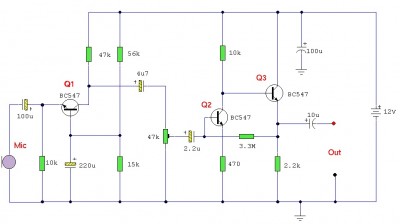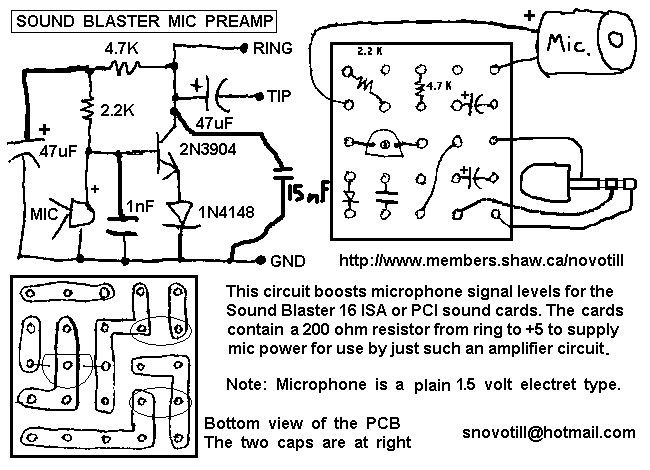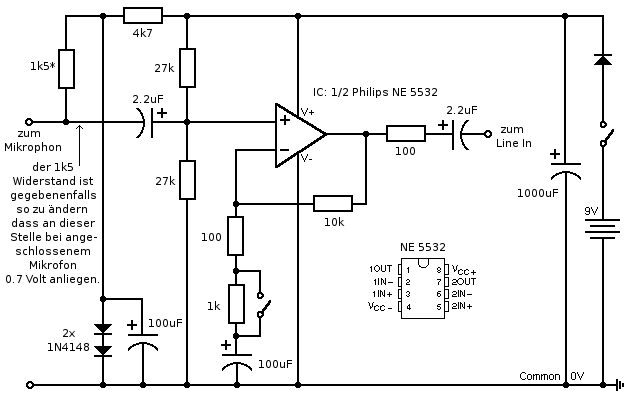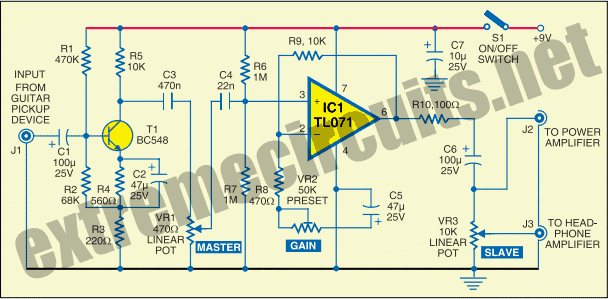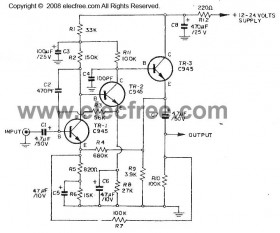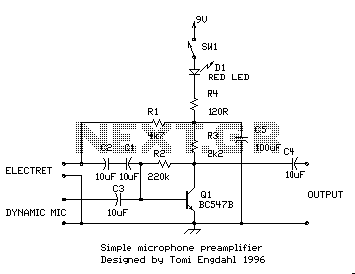
preamp
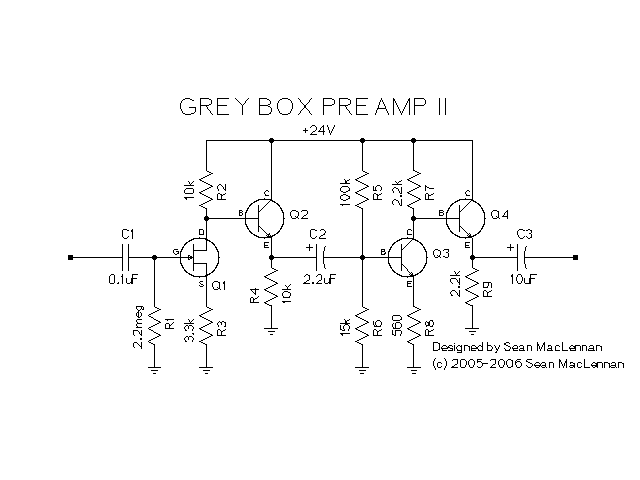
This is a clean preamp designed for use with a bass, a power amplifier, and a cabinet in a rehearsal space. The preamp is a unique design, developed from the ground up. The initial concept was an all-transistor design utilizing only MPSA18 transistors. The original configuration included three stages: an input buffer, a first gain stage, and a second gain stage. The input buffer was adapted from the Acoustic Control 360 Bass Preamp schematic. After testing the original design on a breadboard, it was determined that a FET could effectively provide both high input impedance and the first gain stage, leading to a revised design that eliminated the non-original input buffer. Each stage incorporates paired transistors, with the second transistor serving as a buffer. In the first stage, the buffer enhances the high impedance for the FET to optimize its gain, while in the second stage, the buffer ensures a low output impedance suitable for the power amplifier, which has a 10K input impedance. The output impedance of the NPN gain stage was measured at approximately 3.5K without the buffer and reduced to about 16 ohms with the buffer in place. The first stage is designed for a gain of 2.5 with an Ids of around 1mA, and the second stage is designed for a gain of 4 with an Ic of 5mA, yielding an overall gain of 10, equivalent to 20dB. A 24V supply voltage was chosen as it is readily available in a wall wart style. The 24V supply used generates close to 32V at the low current levels of the preamp, regulated to 24V by an LM7824.
The preamplifier circuit is structured to provide optimal performance for bass guitar applications, where high input impedance and low output impedance are critical for maintaining signal integrity. The use of MPSA18 transistors ensures reliable operation and good thermal stability, while the FET in the first stage allows for a significant input impedance, which is essential for preventing signal loss from the bass guitar.
The circuit can be divided into three main sections: the input stage, the gain stages, and the output stage. The input stage employs a FET, which is known for its high input impedance characteristics. This is crucial for interfacing with passive pickups from the bass guitar, as it minimizes loading effects that could degrade the signal quality. The first gain stage is configured to amplify the signal while maintaining a linear response, with a targeted gain of 2.5.
Following this, the second gain stage further boosts the signal, contributing an additional gain of 4. The design of the second stage includes a buffer transistor, which effectively lowers the output impedance to match the input requirements of the subsequent power amplifier. This ensures that the signal can drive the power amplifier without distortion or loss of fidelity.
The power supply design is also noteworthy. The choice of a 24V supply, regulated by an LM7824, ensures that the circuit operates within a stable voltage range, which is essential for consistent performance. The LM7824 provides a reliable voltage regulation, minimizing fluctuations that could affect the preamp's performance.
Overall, this preamp design is a practical solution for bass players seeking a clean and reliable amplification stage, combining thoughtful component selection and circuit topology to achieve desired audio characteristics.This is a clean preamp that I designed to use with my bass, a power amp, and a cab at a rehearsal space. (Rehearsal space being a fancy name for the singers basement. ) I am very proud of this preamp since, unlike the mu-preamp, I designed it from the ground up. Although there is nothing special about the design, at least it is all mine. The desig n started as an all transistor design using only MPSA18s. ( Original design ) The original design had three stages: input buffer, first gain stage, second gain stage. I did not design the input buffer, I got it from the Acoustic Control 360 Bass Preamp schematic. I breadboarded the original design and it worked. Then I realized that a FET could provide both the high input impedance and the first gain stage. So I switched to the current design. And got rid of the part I did not design in the process. You may notice that the every stage has paired transistors. The second transistor acts as a buffer. For the first stage, it provides a high impedance to the FET to maximize its gain. For the second stage, the buffer is required to provide a nice low output impedance for the power amp.
The power amp I am using has a 10K input impedance. I measured the output impedance of the NPN gain stage without the buffer at about 3. 5K. With the buffer it is about 16 ohms. Much better. The first stage is designed for a gain of 2. 5 and an Ids of about 1mA. The second stage is designed for a gain of 4 and an Ic of 5mA. This provides a gain of 10 which is 20dB. I chose a 24V supply voltage because that is the largest wall wart style supply that is easy to get. The 24V supply I used produces close to 32V at the low current used by the preamp. I used an LM7824 to regulate the voltage to 24V. 🔗 External reference
The preamplifier circuit is structured to provide optimal performance for bass guitar applications, where high input impedance and low output impedance are critical for maintaining signal integrity. The use of MPSA18 transistors ensures reliable operation and good thermal stability, while the FET in the first stage allows for a significant input impedance, which is essential for preventing signal loss from the bass guitar.
The circuit can be divided into three main sections: the input stage, the gain stages, and the output stage. The input stage employs a FET, which is known for its high input impedance characteristics. This is crucial for interfacing with passive pickups from the bass guitar, as it minimizes loading effects that could degrade the signal quality. The first gain stage is configured to amplify the signal while maintaining a linear response, with a targeted gain of 2.5.
Following this, the second gain stage further boosts the signal, contributing an additional gain of 4. The design of the second stage includes a buffer transistor, which effectively lowers the output impedance to match the input requirements of the subsequent power amplifier. This ensures that the signal can drive the power amplifier without distortion or loss of fidelity.
The power supply design is also noteworthy. The choice of a 24V supply, regulated by an LM7824, ensures that the circuit operates within a stable voltage range, which is essential for consistent performance. The LM7824 provides a reliable voltage regulation, minimizing fluctuations that could affect the preamp's performance.
Overall, this preamp design is a practical solution for bass players seeking a clean and reliable amplification stage, combining thoughtful component selection and circuit topology to achieve desired audio characteristics.This is a clean preamp that I designed to use with my bass, a power amp, and a cab at a rehearsal space. (Rehearsal space being a fancy name for the singers basement. ) I am very proud of this preamp since, unlike the mu-preamp, I designed it from the ground up. Although there is nothing special about the design, at least it is all mine. The desig n started as an all transistor design using only MPSA18s. ( Original design ) The original design had three stages: input buffer, first gain stage, second gain stage. I did not design the input buffer, I got it from the Acoustic Control 360 Bass Preamp schematic. I breadboarded the original design and it worked. Then I realized that a FET could provide both the high input impedance and the first gain stage. So I switched to the current design. And got rid of the part I did not design in the process. You may notice that the every stage has paired transistors. The second transistor acts as a buffer. For the first stage, it provides a high impedance to the FET to maximize its gain. For the second stage, the buffer is required to provide a nice low output impedance for the power amp.
The power amp I am using has a 10K input impedance. I measured the output impedance of the NPN gain stage without the buffer at about 3. 5K. With the buffer it is about 16 ohms. Much better. The first stage is designed for a gain of 2. 5 and an Ids of about 1mA. The second stage is designed for a gain of 4 and an Ic of 5mA. This provides a gain of 10 which is 20dB. I chose a 24V supply voltage because that is the largest wall wart style supply that is easy to get. The 24V supply I used produces close to 32V at the low current used by the preamp. I used an LM7824 to regulate the voltage to 24V. 🔗 External reference
